Public awareness continued to play a key role in initiating change. Reporting for the Minneapolis Tribune, Sam Newlund wrote exposés of institutional conditions on January 10, 1965 and April 16, 1967.
Conditions were deplorable, he reported. Children became teens and then adults, all while their disheartening circumstances remained the same.
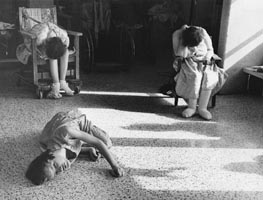
Conditions were deplorable,
according to a Minneapolis Tribune exposé.
STAR TRIBUNE/MINNEAPOLIS-ST. PAUL 2009.

Video: Sam Newlund, Star Tribune reporter, who covered state social service activities and with photographer Earl Sieffert did an impactful story on hospital conditions.
Part 1: Unannounced Visit and the Exposé of Faribault State Hospital
Part 2: Comparing Kansas and Minnesota Conditions
Part 3: A Reporter’s First Hand Account
In response, the Department of Public Welfare initiated the Cambridge Moose Lake Project and began transferring people with developmental disabilities from Cambridge to Moose Lake, a traditional community mental health hospital.
Originally prompted by overcrowding, the regionalization movement had begun.
By regionalizing services, people with developmental disabilities could be cared for closer to their homes. Hospitals started serving multiple groups and school districts began paying for school programs within the institutions.
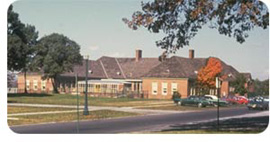
The Cambridge Moose Lake Project marked the start of the regionalization movement.
In 1965, Minnesotan Dickie Bach of Columbia Heights was selected Arc's national "poster child of the year."
The national campaign, chaired by Muriel Humphrey, used the slogan "Give as if he were your own" to generate giving.

Poster Child of the Year and Muriel Humphrey,
Arc's National Chair in 1965.
In 1966, Brainerd State Hospital created an experimental day camp. The hospital also constructed two bowling alleys for residents.
No one could have predicted the popularity bowling would have in such settings, nor its dominance in improving quality of life for people with developmental disabilities.
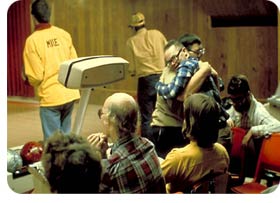
Bowling played an important role
in improving quality of life.
In 1966, the Cambridge hospital opened a day program for 73 young girls.
To address the peonage issue, residents of all state hospitals could apply to become civil service workers and skip the required exams.

An innovative Day Program
at Cambridge began in 1966
In June 1966, Governor Rolvaag issued a declaration of basic rights for people with developmental disabilities. These rights included:
- The right to live without privation,
- The right to be useful,
- The right to individual care, help, education, acceptance, job, clarity and efficiency.
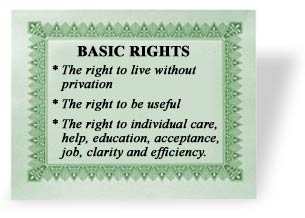
In 1966, Governor Rolvaag outlined rights
for people with developmental disabilities.
By 1965, community care was in its infancy, serving 1,545 people. However, access to community care would soon explode.
While it cost less to serve people in private facilities, the state still paid only for services delivered through state hospitals.
Public pressure mounted to have the state pay for a portion of the expense of caring for people living in private facilities. The result was a reimbursement system that capped parent payments at $10 a month. The remainder of the cost was shared by counties and the state.
Video: Milt Conrath acted as a witness during the Welsch trial regarding the conditions and practices of state hospitals.
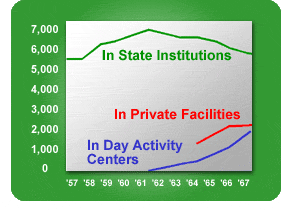
During the 1960s, the number of residents in Day Activity Centers and Private Facilities grew at an increasing rate.
Using a Title 1 grant of the Elementary and Secondary Education Act, the Cambridge hospital introduced Project TEACH in 1967.
It put into practice the theory that children can develop "life" skills and become self-sufficient if given appropriate individual attention.










